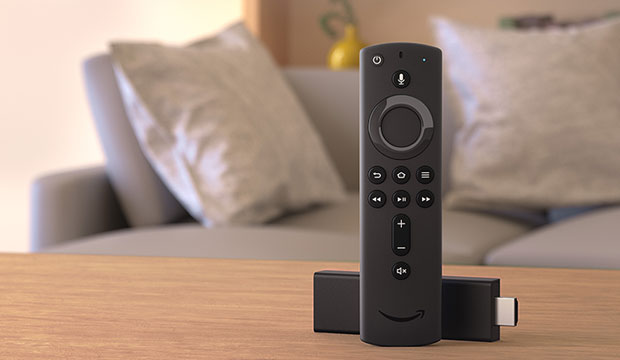In six short years Amazon has risen from worst to first in the video streaming pack, according to a survey released by a consumer market research firm.
In its annual survey of the smart TV and streaming box market, Parks Associates revealed that Amazon, which had a lowly 12 percent of the streaming video market in 2015, surged to a 36 percent share during the first quarter of this year.
Amazon shares top honors with Roku, which also has 36 percent of the market, followed by Apple (12 percent), Chromecast (eight percent) and all others (six percent).
While Amazon’s fortunes have gone up since 2015, Google’s Chromecast’s have declined from its high point in that year of 21 percent.
However, Chromecast’s standing could change. “Our results were first quarter survey results,” explained Parks analyst Paul Erickson.
“The new Chromecast for TV wasn’t launched until the end of the year so it’s still early to see how that will impact the Google user base. We may not see that impact for a quarter or two,” he told TechNewsWorld.
“The stats we’re seeing are very U.S.-centric, which is a base of Amazon’s strength. It might be different if we were looking at Europe or somewhere else,” he cautioned.
A contributing factor to Amazon’s rise in the streaming ranks has been its aggressive marketing, he continued.
“Plus they run one of the largest e-commerce sites in the world. It’s a huge venue for them to market their devices,” he said.
“They’re not just capturing their Prime subscriber base with these devices,” he added. “They’re capturing a lot of general consumers that shop on Amazon and see the devices offered at a discounted price or they see it bundled with something they want at a discounted price.”
Three Keys to Success
IDC analyst Adam Wright sees three contributors to Amazon’s success in the streaming market: its content and services strategy, its hardware strategy and its leveraging of its broader smart home ecosystem and brand.
“Over the past few years, Amazon has done an excellent job in building out a user-friendly streaming platform that delivers a wide range of channels and content — to the point where any previous major competitive edge or difference between Amazon and competitors like say Roku have been whittled down,” he told TechNewsWorld.
“Amazon has built out an attractive portfolio of streaming content — both original content via Prime Video and third-party content — and it has also partnered with the right streaming platforms like HBO and Paramount and a plethora of others to deliver content that consumers are interested in,” he said.
But Amazon’s success also lies beyond just the Fire TV streaming platform and streaming content, he added. Amazon has done an exceptional job in developing its own hardware that is constantly being updated with new features, including things like 4K capabilities, HDR and Dolby Atmos for better picture and sound quality.
Moreover, he continued, it has been exceptionally aggressive in its pricing strategy, to the point where we see frequent and significant discounts of Amazon Fire TV streaming players and also lots of bundling of these streaming sticks and streaming boxes with other smart home devices, which helps to drive sales and grow their user base.
Weak Competition
In addition, Amazon has built a very broad and robust ecosystem of smart home devices — ranging from smart speakers, smart displays, smart plugs, smart appliances, smart security solutions, smart lights and many more — which has generated spillover effects and is helping to drive sales of Amazon’s streaming players, Wright explained.
Tight integration of Amazon’s digital assistant, Alexa, is also contributing to the success of its streaming devices.
“Being able to use voice commands to control the TV functionality or to search for content, or even to pull up a live view of a video doorbell or control a light elsewhere in the home is a big draw for many consumers,” Wright maintained.
Much of Amazon’s success over the last six years has been at the expense of its competitors.
“Apple has never put much emphasis at all on TV in any form. They’ve only made a token effort,” maintained Jim Nail, a principal analyst with Forrester Research.
“And the TV business really isn’t big enough for Google to worry that much about,” he told TechNewsWorld.
Erickson added that Apple is very focused on its own ecosystem. “The price of its offerings reflect that,” he continued. “They are not competing with Main Street devices by pricing their devices at $149 and up when the majority of the volume in the market now is $50 or less.”
Wright asserted that Apple’s market share has suffered significantly because it fell behind in the smart home race early on and doesn’t have as much of an ecosystem to leverage, compared to Amazon, for driving sales of devices and generating those ecosystem spillover effects.
“Google never offered much of a range or updates when it comes to the hardware, only recently receiving some revitalization with the launch of its new Chromecast with Google TV,” he said.
New Growth Opportunities
Other competitors, though, like Roku, are continually looking for new ways to grow.
“A lot of the volume of streaming device makers these days is in licensing,” observed Ross Rubin, the principal analyst with Reticle Research, a consumer technology advisory firm in New York City.
“They’re the TV operating systems behind a lot of brands,” he told TechNewsWorld “Amazon has done a little bit of work there but not as much as Roku.”
“Roku has also moved into making home theater equipment, like soundbars, with Roku software embedded in it, and offering its own content, through the Roku Channel and the recent purchase of the library of the short-lived short-form video streaming service Quibi.”

Gaming could also be fertile territory for streaming device makers.
“All these guys have experimented with games,” Rubin said. “There may be some room for growth there because streaming game service operators like Microsoft, Amazon and Nvidia want to expand to television because, in many cases, the games that they’re streaming were originally designed for a TV-like interface.”
If there’s one cloud on the horizon for streaming device makers, it could be the smart TV.
“I think one of the most pertinent factors that will have an increasing impact over the next three to five years is the rise of smart TVs,” Wright said.
“Currently, our surveys indicate that consumers are still buying streaming sticks at the same time they buy a smart TV, even though that smart TV can stream content,” he continued. “The reason is that the capabilities of smart TVs are yet to match those of streaming players.”
“But smart TV makers are catching up quickly,” he added, “and I think that we’re going to see streaming players face some stiff competition from the smart TVs in the coming years.”

























































